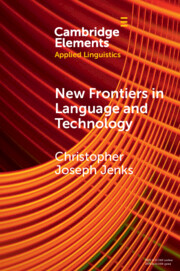Refine search
Actions for selected content:
15 results
Integrating biomaterials and interactive technologies: practice-based perspectives on the growth of biodesign within human-computer interaction
-
- Journal:
- Biotechnology Design / Volume 4 / 2026
- Published online by Cambridge University Press:
- 27 August 2025, e3
-
- Article
-
- You have access
- Open access
- HTML
- Export citation
Linguistic alignment of redundancy usage in human-human and human-computer interaction
-
- Journal:
- Applied Psycholinguistics / Volume 46 / 2025
- Published online by Cambridge University Press:
- 15 August 2025, e22
-
- Article
-
- You have access
- Open access
- HTML
- Export citation
Simulation framework and development of the Future Systems Simulator
-
- Journal:
- The Aeronautical Journal / Volume 128 / Issue 1330 / December 2024
- Published online by Cambridge University Press:
- 06 November 2024, pp. 2754-2780
-
- Article
-
- You have access
- Open access
- HTML
- Export citation

New Frontiers in Language and Technology
-
- Published online:
- 16 June 2023
- Print publication:
- 13 July 2023
-
- Element
- Export citation
The Sharing Game: Fairness in resource allocation as a function of incentive, gender, and recipient types
-
- Journal:
- Judgment and Decision Making / Volume 2 / Issue 3 / June 2007
- Published online by Cambridge University Press:
- 01 January 2023, pp. 204-216
-
- Article
-
- You have access
- Open access
- HTML
- Export citation
EXPLORATORY RESEARCH ON CULTURAL COMPUTING FOR HUMAN-COMPUTER INTERACTION. THE CASE OF SUSTAINABILITY.
-
- Journal:
- Proceedings of the Design Society / Volume 1 / August 2021
- Published online by Cambridge University Press:
- 27 July 2021, pp. 1471-1480
-
- Article
-
- You have access
- Open access
- Export citation
Augmented reality for maritime navigation data visualisation: a systematic review, issues and perspectives
-
- Journal:
- The Journal of Navigation / Volume 74 / Issue 5 / September 2021
- Published online by Cambridge University Press:
- 12 May 2021, pp. 1073-1090
- Print publication:
- September 2021
-
- Article
- Export citation
3 - Understanding Weapon Autonomy
-
- Book:
- Autonomous Weapon Systems and the Law of Armed Conflict
- Published online:
- 17 June 2020
- Print publication:
- 09 July 2020, pp 28-56
-
- Chapter
- Export citation
IMPRO: IMMERSIVE PROTOTYPING IN VIRTUAL ENVIRONMENTS FOR INDUSTRIAL DESIGNERS
- Part of
-
- Journal:
- Proceedings of the Design Society: DESIGN Conference / Volume 1 / May 2020
- Published online by Cambridge University Press:
- 11 June 2020, pp. 1375-1384
-
- Article
-
- You have access
- Open access
- Export citation
6 - Design Comes to the Law School
-
-
- Book:
- Modernising Legal Education
- Published online:
- 30 December 2019
- Print publication:
- 09 January 2020, pp 109-125
-
- Chapter
- Export citation
An overview of augmented visualization: observing the real world as desired
-
- Journal:
- APSIPA Transactions on Signal and Information Processing / Volume 7 / 2018
- Published online by Cambridge University Press:
- 18 October 2018, e12
- Print publication:
- 2018
-
- Article
-
- You have access
- Open access
- HTML
- Export citation
Law Student Views on the Principles of a Legal Research Website: a User Experience Study
-
- Journal:
- Legal Information Management / Volume 16 / Issue 3 / September 2016
- Published online by Cambridge University Press:
- 26 September 2016, pp. 187-196
- Print publication:
- September 2016
-
- Article
- Export citation
Survey on audiovisual emotion recognition: databases, features, and data fusion strategies
-
- Journal:
- APSIPA Transactions on Signal and Information Processing / Volume 3 / 2014
- Published online by Cambridge University Press:
- 11 November 2014, e12
- Print publication:
- 2014
-
- Article
-
- You have access
- Open access
- HTML
- Export citation
25 - AnEvaluation of Computational Modeling in Cognitive Science
- from Part IV - Concluding Remarks
-
-
- Book:
- The Cambridge Handbook of Computational Psychology
- Published online:
- 05 June 2012
- Print publication:
- 28 April 2008, pp 667-683
-
- Chapter
- Export citation

